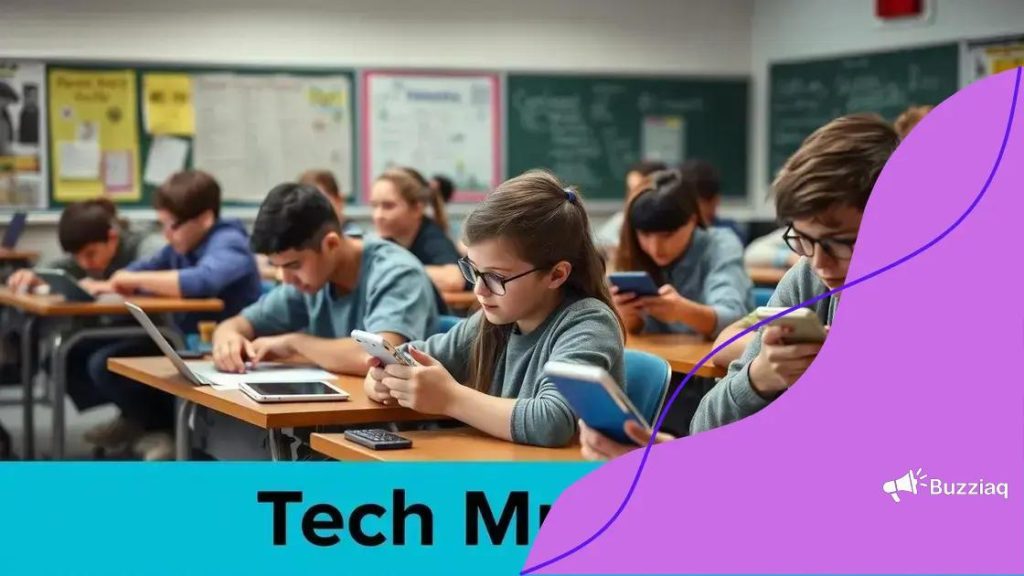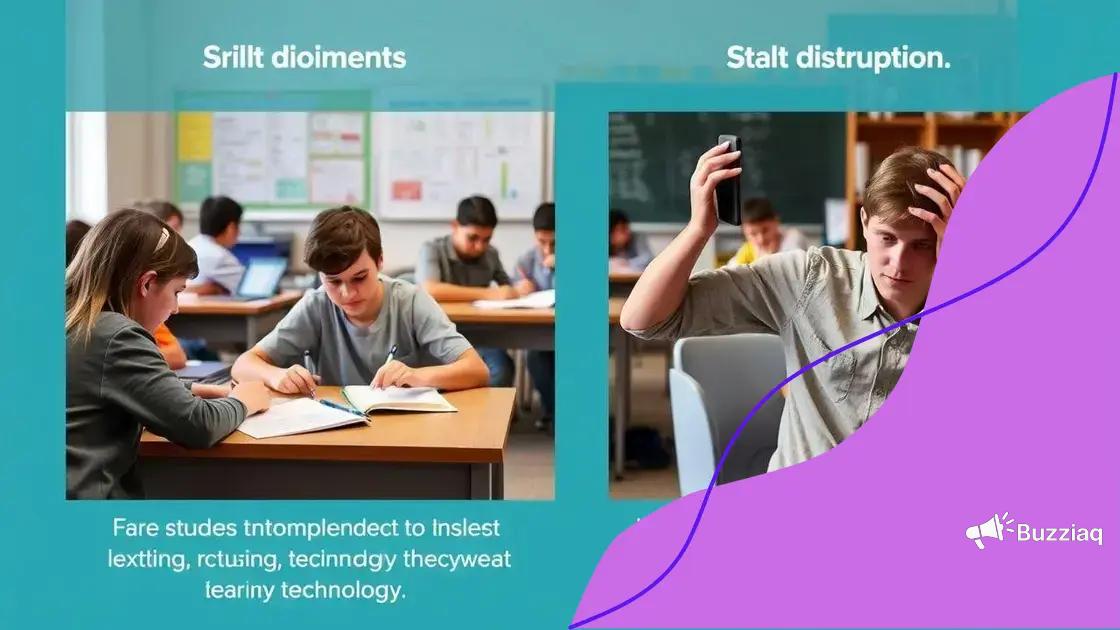Misuse of tech devices in class: unmasking the impact

AD
The misuse of tech devices in class leads to distractions that negatively affect student learning and behavior, making it essential for schools to establish clear guidelines and a balanced tech policy.
Misuse of tech devices in class has become a pressing concern for educators today. With the rise of digital tools in education, it’s crucial to examine how their misuse affects learning and engagement. What can be done to address this challenge?
AD
Understanding tech misuse in classrooms
Understanding tech misuse in classrooms is critical for both educators and students. Many teachers face challenges with students distracted by their devices. Proper awareness can help tackle this issue effectively.
Common scenarios of misuse
There are several ways technology can be misused in educational settings. Distractions can arise from social media, gaming, or browsing unrelated content during lessons.
- Checking social media notifications
- Playing games instead of focusing on lessons
- Using devices to cheat on assignments
Another aspect to consider is how teachers are affected by tech misuse. An engaged classroom relies on students’ attention, which can be tough when devices are misused. This situation can lead to disruptions and a less productive learning environment.
AD
Factors influencing misuse
Several factors contribute to the misuse of technology in class. For instance, the age of students can significantly impact their ability to manage their device usage.
Additionally, peer influence plays a crucial role. Students often mimic their friends’ behavior, whether good or bad. Therefore, fostering a culture of responsibility is essential. Educators should guide students on appropriate device use. This can create a more focused atmosphere and allow everyone to benefit from technology.
Common types of misuse by students
Identifying the common types of misuse by students is essential for educators. It helps in finding effective ways to manage technology in the classroom. Many students have access to smartphones and laptops, which can lead to various distractions.
Types of tech misuse
Some of the most frequent forms of misuse include:
- Using social media during class, which diverts attention from learning.
- Playing video games instead of focusing on assignments, leading to a drop in academic performance.
- Texting friends or engaging in non-educational chats, interrupting the learning flow.
- Searching for information unrelated to the lesson, which can confuse students regarding class objectives.
Each type of misuse has a different impact on the classroom dynamic. For instance, when a student is distracted by their phone, it not only affects their own learning but also distracts nearby peers. Teachers often struggle to regain the students’ attention once it is lost.
Impact on learning
Misuse of technology can result in negative consequences. Engaging with distractions can lead to incomplete work and lower grades. Furthermore, it creates a challenging environment for teachers trying to maintain focus. To mitigate these issues, it’s vital for students to be educated on responsible device usage.
Establishing clear guidelines on what is acceptable during class can help curb misuse. Encouraging students to use technology as a learning tool rather than a source of distraction promotes a healthier classroom culture.
Impact on learning and student behavior

The impact of tech misuse on learning and student behavior is significant. When students use devices inappropriately, both their academic performance and classroom dynamics may suffer. Distractions can hinder a student’s ability to retain information.
Effects on academic performance
Misuse of technology often leads to lower grades. When students focus on social media or games instead of the lesson, they miss out on important content. This, in turn, affects their ability to participate in discussions and perform well on tests.
- Increased chances of missing assignments
- Lower test scores due to lack of focus
- Difficulty grasping key concepts taught in class
The consequences of tech misuse extend beyond grades. For example, students may develop poor study habits. Relying on devices for entertainment rather than education can lead to procrastination and a lack of motivation.
Behavioral changes in students
Tech misuse can also alter students’ behavior. When distracted, they may become disengaged or disrespectful toward their teachers and peers. This can create a disruptive classroom environment. Teachers often find it challenging to regain control once students become inattentive.
Encouraging responsible use of technology is crucial. By guiding students on how to use their devices wisely, schools can promote a more focused and respectful classroom atmosphere. Merging educational content with constructive technology usage helps students stay engaged and connected to their learning.
Strategies to minimize device misuse
Finding effective strategies to minimize device misuse is essential for creating a productive classroom environment. When students are guided in using their technology responsibly, learning can flourish.
Establish clear rules
One of the first steps is to set clear rules regarding device usage during class. Students should understand what types of activities are acceptable. Clear guidelines can help them manage their focus and responsibilities better. Some examples of rules may include:
- No social media during class time.
- Devices should only be used for educational purposes.
- Charging devices before class to prevent distractions.
Communicating these rules clearly and consistently helps students stay aware of expectations.
Incorporate technology in lessons
Another effective strategy is to integrate technology into learning activities. When students see how technology can enhance their education, they’re more likely to use it positively. Incorporating interactive lessons or educational apps makes lessons engaging.
For instance, using interactive polls or quizzes can maintain students’ focus while using devices. It’s essential to make the technology a tool for learning rather than a source of distraction.
Monitor and encourage responsibility
Teachers should also monitor students’ usage closely. Walking around the classroom and engaging in discussions can help maintain a focused atmosphere. Encourage students to take ownership of their tech habits. They can set personal goals for staying focused and evaluate their progress.
Discussing the consequences of misuse openly can lead to better understanding among students. When students comprehend the impact of distractions on their learning, they might be more motivated to succeed.
Creating a balanced tech policy for schools
Creating a balanced tech policy for schools is vital for fostering a positive learning environment. A well-designed policy addresses both the benefits and challenges of technology in education. It helps guide teachers and students in using technology effectively.
Defining the purpose of technology in education
The first step in crafting a balanced policy is clearly defining how technology will be used to enhance learning. Schools should consider the specific goals they want to achieve with tech integration. This can include:
- Improving student engagement.
- Supporting personalized learning.
- Facilitating collaboration among students.
When everyone understands the purpose, it becomes easier to create rules and guidelines that align with those goals.
Involving stakeholders in the policy-making process
Involving key stakeholders in developing the tech policy is essential. Teachers, administrators, parents, and even students can provide valuable insights. Conducting meetings or surveys can help gather diverse perspectives. This participatory approach ensures the policy is comprehensive and practical.
Furthermore, including input from students can promote ownership and responsibility. When they have a voice in the process, they are more likely to adhere to the guidelines.
Establishing clear guidelines and consequences
Once the purpose is defined and input is gathered, it’s important to establish clear guidelines regarding device usage. These guidelines should cover acceptable use, screen time limits, and what constitutes misuse. Additionally, providing clear consequences for violations is essential to maintain accountability.
A balanced tech policy should also encompass flexibility. As technology evolves, policies may need to be adjusted to meet new challenges and opportunities. Regular evaluations and updates can keep the policy relevant and effective.
In summary, addressing the misuse of tech devices in class is vital for fostering an engaging and effective learning environment. By understanding the common types of misuse, their impact on learning and behavior, and implementing strategies to minimize distractions, schools can create a more balanced approach to technology. Creating a solid tech policy with input from all stakeholders ensures that both students and teachers can benefit from technology while maintaining focus on educational goals. A collaborative effort will help cultivate responsible use of devices and enhance the overall classroom experience.
FAQ – Frequently Asked Questions about Misuse of Tech Devices in Class
What are common examples of tech misuse in classrooms?
Common examples include using social media, playing games, texting during class, and browsing unrelated content.
How does tech misuse affect student learning?
Tech misuse can lead to distractions, lower academic performance, and difficulty grasping important concepts.
What strategies can schools implement to reduce device misuse?
Schools can establish clear rules, incorporate technology in lessons, and regularly monitor student usage to minimize misuse.
Why is a balanced tech policy important for schools?
A balanced tech policy helps define acceptable use, involves stakeholders in the decision-making process, and promotes responsible technology usage.